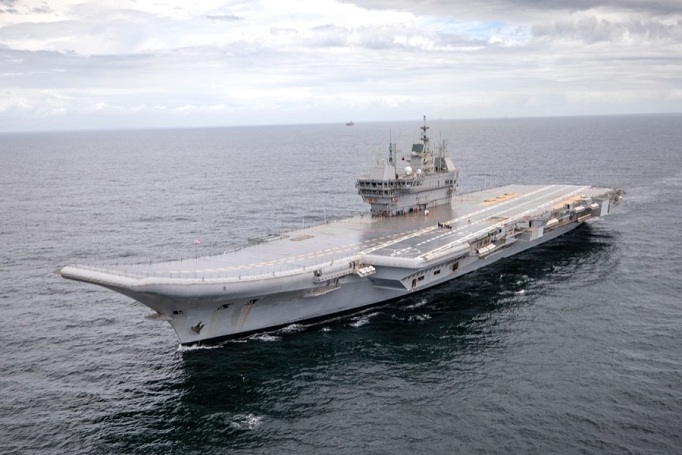Self Reliance
| Date :08-Aug-2021 |

By ANSHUMAN BHARGAVA :
Today the old INS Vikrant is gone but in its place we have a more modern and capable warship and more importantly, unlike the older one, this one is proudly made in India.
INS Vikrant, also known as Indigenous Aircraft Carrier 1 (IAC-1), is the first aircraft carrier to be built in India. The name Vikrant (Sanskrit vikranta, literally “stepping beyond”) means “courageous”. The motto of the ship is “Jayema Sam Yudhi Spardhah”, which is taken from Rigveda and can be translated as “I defeat those who fight against me”.

INS Vikrant is a name synonymous with valour and pride and harks back to a glorious history of an iconic aircraft carrier that served the Indian Navy for decades and bolstered Indian Army’s capability manifolds. Today the old INS Vikrant is gone but in its place we have a more modern and capable warship and more importantly, unlike the older one, this one is proudly made in India. This is a shot in the arm for the Modi Government’s initiative to boost domestic manufacturing and technological capacity for self reliance. India is one of the largest importers of arms in the world and the lion’s share of her annual expenses goes into buying arms, which drains us of our financial resources. If we could invest in our own capacity building and enhance our production capabilities, we could match China and the US in our military projection. INS Vikrant, also known as Indigenous Aircraft Carrier 1 (IAC-1), is the first aircraft carrier to be built in India. The name Vikrant (Sanskrit vikranta, literally “stepping beyond”) means “courageous”. The motto of the ship is “Jayema Sam Yudhi Spardhah”, which is taken from Rigveda and can be translated as “I defeat those who fight against me”.
The ship shall operate MiG-29K fighter aircraft, Kamov-31 Air Early Warning Helicopters, the soon to be inducted MH-60R multi-role helicopter and the indigenously manufactured Advanced Light Helicopters. It would offer an incomparable military instrument with its ability to project Air Power over long distances, including Air Interdiction, Anti-Surface Warfare, offensive and defensive Counter-Air, Airborne Anti-Submarine Warfare and Airborne Early Warning. Praising the success of the Cochin Shipyard and Indian Navy in giving shape to the mega project, Defence Minister Rajnath Singh said, it is a shining example of Aatmanirbhar Bharat as envisioned by Prime Minister Narendra Modi. He said that IAC has nearly 75 per cent indigenous content - from design to steel used in construction to key weapons and sensors. the IAC project includes raw materials that include 23,000 tons of steel, 2,500 kilometres of electrical cables, 150 kilometres of pipes and 2,000 valves as well as finished products such as anchor capstans, rigid hull boats and LCVPs, galley equipment, air conditioning and refrigeration plants, most of which are made in India. It also has steering gear, RO plants, main switchboards, energy distribution centres, more than 150 pumps and motors, AK 630 guns, chaff launchers, internal and external communication equipment, all network systems including a ship data network, Integrated Platform Management System and Combat Management System. Over 50 Indian manufacturers have been directly involved in this project, which has provided significant employment opportunities to Indian hands and minds.
Close to 2,000 Indians received direct employment onboard IAC on a daily basis and over 40,000 received indirect employment. In addition, about 80-85 per cent of the project cost of approximately Rs 20,000 crore has been ploughed back into the Indian economy. INS Vikrant, when commissioned next year, will be India’s most potent sea-asset for its reach and versatility is nullifying enemy offensive. For the uninitiated, the design and construction of the IAC was sanctioned by the Government in January 2003. The keel of the ship was laid in February 2009 by then Defence Minister AK Antony. The original plans for the ship were floated in 1989, the design work began fresh in 1999, after then Defence Minister George Fernandes gave nod for the project stuck due to a number of reasons, including financial crunch. It was scheduled for commissioning in 2018 but was delayed. It is only after the present dispensation came to power and expedited things that the project started moving fast after 2014 and saw its completion this year. Had it not been for the COVID setback, the 40,000-tonne ship would have been inducted by now. Navy sources say the IAC is the most complex warship building project to have been indigenously designed and built. The 262-metre-long and 62-metre-wide carrier can hold 35-40 aircraft of different sizes at one time.
It would offer an incomparable military instrument with its ability to project air power over long distances, including air interdiction, anti-surface warfare, offensive and defensive counter-air, airborne anti-submarine warfare and airborne early warning. It also has two 32 cell VLS (Vertical Launch System), capable of firing 64 missiles in total. The success of the project is not only a milestone for Indian scientists and engineers and a testimony to our indigenous prowess but also gives India a position of power in the volatile South Asian region that China eyes to dominate. India needs to up its manufacturing edge and lower its dependence on other countries to get arms. This is important not only to save costs but also for timely availability of weapons that is often delayed due to tech transfer intricacies and other logistic and legal or diplomatic hurdles as also international situations.
Once we start large scale and diverse production of weaponry at home, we can also start selling our weapons to other countries to help our revenues. More focus on research and development and continued pursuit of excellence through greater production will give us more scope to innovate and improvise to better our skills and possibilities. We must not stop here but only expand our facilities to manufacture more, diversify more and upgrade faster to match the best practices in the field. Our paraphernalia and ancillary support has to be geared up to create an ecosystem that is conducive to fostering a culture of research, skill development and manufacturing capability. These gaps and missing links in the cogs of success keep us from delivering our best and stand up to our potential. Once we plug those loopholes, we can exhibit excellence in all fields of modern day indicators that enhance a country’s heft and prestige in the global balance of powers. India is a major counter force to stall China’s ascendancy in the world and the strength of India in the modern world will be decided by the amount of technology, skill and manufacturing ability she has. She has all, only their efficient application is the key. By the way, if the Government can propel India out of the traditional rut and set her in motion on the right trajectory through aggressive and drastic policy changes, India can come up as an unstoppable power, which no country can rival.